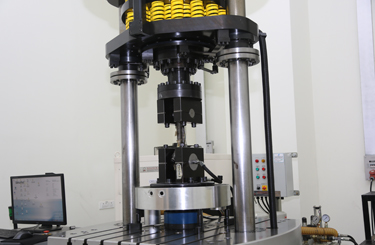Resonating Pulsator
Resonance testing machines are vibration systems. The system can be considered as an arrangement of springs, masses and dampers. In this point of view the specimen is a spring with a low damping factor. The machines can be designed as push/pull, torsion or bending test machines. Depending on the design an additional static load can be applied. Typical arrangements are created as one-, two- or three-mass-systems etc.
The behaviour is determined by the parameters stiffness of the springs, masses and damping factors. Very high forces are achieved if the testing machine (or: the vibration system) is excited in its natural (resonance) frequency.
The height of this resonance amplification depends in the first instance on the damping in the system. Specimens of metallic materials have normally low damping, so these parts can be tested very efficient with resonance testing machines. Specimens with high damping, e.g. specimens of elastic materials, have only very low resonance amplifications and are not suitable for resonance testing machines.
The POWER SWING MOT series is excited with an unbalanced mass system. Thus the excitation force depends on the speed of the rotating mass. The load applied to the specimen can be varied by changing the speed of the unbalanced mass. The machine is operating in the rising part of the resonance curve.
If a crack is growing in the specimen its stiffness is changing and subsequently the natural frequency is changing too. The controller is reducing the speed of the rotating mass to keep the load constant.
Furthermore the frequency drop is likely to detect a failure of the specimen.


The POWER SWING MOT series is excited with an unbalanced mass system. Thus the excitation force depends on the speed of the rotating mass. The load applied to the specimen can be varied by changing the speed of the unbalanced mass. The machine is operating in the rising part of the resonance curve.
If a crack is growing in the specimen its stiffness is changing and subsequently the natural frequency is changing too. The controller is reducing the speed of the rotating mass to keep the load constant.
Furthermore the frequency drop is likely to detect a failure of the specimen.
